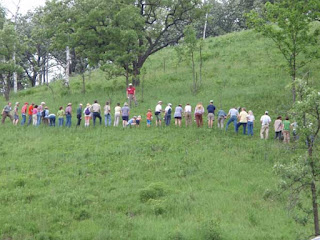Prairie and savanna plant species present at Pleasant Valley Conservancy before restoration
We were fortunate that in 1995-1997, before any restoration
work had begun at Pleasant Valley Conservancy, several plant species lists were prepared by competent
botanists. Later, after Kathie became more familiar with the property, she added
more species.
I put these lists together and added quite a few other
species that had been missed because they were in remote parts of the property
or would not have been visible at the time of year when the original observations were
made.
There were 311 species that were present before any
restoration or seeding, which is impressive. Also, quite a few of these species
are very desirable, with high Coefficients of Conservation (C values). The complete list is given at this link.
As part of my work on the history of PVC, I was interested
to see where these species had been originally found, thinking that may give
some idea of how they were able to hang on without human help. The table shows
the principal locations, and lists the most interesting species.
In the very high quality 1990 air photo shown here the locations
of the two largest prairies can be seen. Also there are quite a few smaller areas that had
not (yet) brushed in.
Site
|
Species
|
Notes
|
County F road bank
|
82
|
Mostly savanna; a few also found in prairies, lots of golden
Alexanders; important collecting site, especially for savanna species
|
North Woods
|
5-10
|
Large populations of Trillium grandiflora and large lady
slipper orchid
|
Toby’s Annex
|
5-10
|
Flowering spurge, Missouri goldenrod, Showy goldenrod, little
bluestem, Indian grass
|
Unplowed north side of what is now Toby’s Prairie
|
1
|
Large population of Baptisia alba
|
Kathie’s Prairie (Unit 1)
|
37
|
Lead plant, sky-blue aster, purple prairie clover, small
yellow flax, fringed puccoon, short green milkweed, Agalinis gattingeri, violet
wood sorel, small skullcap, blue-eyed grass, gray goldenrod, prairie
dropseed, bird’s foot violet
|
Tom’s Prairie (Unit 4)
|
19
|
Lead plant, sky-blue aster, fringed and hoary puccoon,
violet wood sorrel, prairie turnip, blue-eyed grass, prairie dropseed, bird’s
foot violet, prairie violet
|
Remnant area of Unit 11A
|
2
|
Lead plant, New Jersey tea
|
White Oak Savanna
|
1
|
Large population of shooting star
|
Unit 18
|
4
|
Virginia wild rye, spiderwort, white baneberry, red baneberry,
|
Wetland
|
>100
|
No seeding has been done; sweet Indian plantain, glade
mallow, swamp milkweed
|
Oak savanna areas
|
various
|
poke milkweed, purple milkweed, spikenard, wild sarsaparilla,
|
In addition to these larger sites, a number of smaller
prairie remnants existed at Pleasant Valley Conservancy at the time restoration
work began. Most of these were areas that had not been plowed, or had been too
far from the barn for much grazing. Some of these remnants were important
because they were the sources of seeds of particular prairie or savanna species.
Seeing this summary makes one realize that there is good hope
for many other so-called degraded sites!
A detailed study of the 1990 air photo is interesting. Many
south-facing hillsides like this one had at this date been completely covered with
red cedar, which is very invasive and spreads rapidly. Why is this slope still
fairly open?
The photo was taken before leaf-on, so the only green seen
are conifers. However, almost all of these conifers were red pines that had
been planted by a former owner. There were a few red cedars, but only scattered. I
think the presence of the pines had kept the cedars from taking hold. And the
rest of the vegetation on the south-facing slope was deciduous, either shrubs
or trees.
We began clearing this hillside in the winter of 1997-1998
and finished it in 1999-2000. Now with many burns and extensive seeding, it is
a highly diverse tallgrass prairie!
 |
| Air photo taken April 13, 1990 (from Dane County Regional Planning Commission) |






